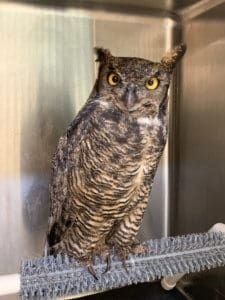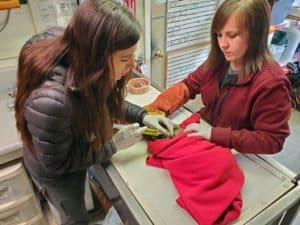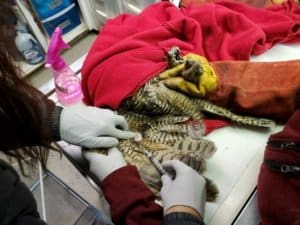 Party in the Hundred Acre Wood…
Party in the Hundred Acre Wood…
The before and after shots of this patient say it all! A great horned owl was barely recognizable when found skunked and covered in manure on a local farm! The woman who found him thought the creature was a Gremlin for a moment, before realizing the owl needed help after the worst weekend of his life.
You could smell Patient 19-955 before you saw him when he arrived Saturday, September 28. Covered in manure, mud, and plant matter and reeking of skunk he was a sad sight. Out of 1000+ wild patients, very few are so incredibly expressive upon intake. We imagine the photo taken to document the birds terrible condition must have exactly matched his feelings about the matter. When posted on social media community members immediately referenced how dejected, embarrassed, ashamed and guilty the patient looked for what could have only been a weekend of mayhem.
Weekend Shenanigans…
We can’t be certain on what happened to Patient 19-955 out on a rural Ashland property… so far he is pleading the fifth. The story may have gone like this…
Hungry owl sees delicious skunk. Skunk defends itself with foul liquid. Owl temporarily disabled by potent defense mechanism. Owl tailspins into manure pile. Owl struggles in wet field until a giant being appears to help. End scene.
While we are careful to not personify our patients – since, afterall, they are wild animals… with this particular case it’s difficult. Many people on Facebook pointed out that he must have been out drinking with his buddies, got beat up by the local raptor gang, lost an epic dance off with the skunk, or did the toughest workout on the planet… either way – we know two facts: Great horned owls love skunk. Great horned owls have a terrible sense of smell.
Feathered Friends Flock Together…
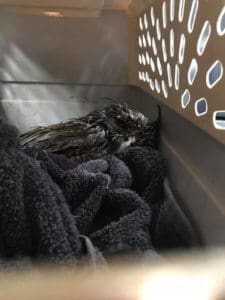

As a non-profit, Wildlife Images puts in a great deal of effort to keep costs as low as possible so that every dollar donated goes to the care of wild patients and Animal Ambassadors. It is extremely time consuming and financially draining to retrieve animals who need care from across southern Oregon. We rely on people to bring injured or orphaned wildlife to our center in Grants Pass. Sometimes that isn’t always possible. In this case, the woman who found Patient 19-955 couldn’t make the drive to Wildlife Images so she asked on a Facebook group if anyone could help. Another woman was willing to make the drive but would need gas money. People donated enough to cover the travel costs to Wildlife Images. So the rescuer and the transporter met at a grocery store for a hand off neither one of them will ever forget! Did you know that smell is the believed to be more closely linked to memory than any other sense. 😉
Nose-blind Clinic Crew…
Oh, how we wish this were true. Unfortunately, we still smell all the smells… and there are a lot of them. When Patient 19-955 arrived a quick exam revealed no major injuries. The next step was a bath before we could assess him for any other injuries or issues. Covered in manure, mud and who knows what else for who knows how long left him in pretty bad shape. His feathers were matted together in many places, he was soaked through to the skin and quite cold. Since we didn’t see any evidence of a greasy or oily substance on him we decided to simply use warm water. Dawn dish soap has long been the standard for washing animals – with good reason, but this isn’t necessary if the animal is covered in something water soluble – like manure and mud. By not using soap we were able to speed up the bath which reduces the exposure to humans and the stress on the patient. The warm water helped raise his body temperature as the Animal Care team gentle rinse him off. As each wing was spread out we found grass and even dandelions stuck among his feathers. Following his bath, Patient 19-955 was placed on a perch in an ICU kennel with a heater to help him dry out.
This patient would likely not have recovered in the wild since his feathers were so compromised and because of the time of year. Like all birds, owls preen themselves. This means they use their beak and talons to remove dust, dirt or small amounts of grease. In fact, the two outside talons are called “feather combs” which they use to clean their head. They have tiny bristles on them so they really are like combs! Birds have five different types of feathers and have a different purpose. Most owls even have a cool adaptation on their feathers that allows them to be silent hunters unlike other members of the raptor family.
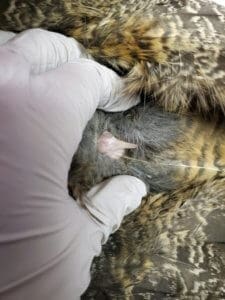
The other thing that birds rely on is their uropygial gland. This tiny organ produces a liquid which essentially waterproofs their feathers. Once that waterproofing is damaged – as it was with this guy – it can take weeks for the feathers to become ready for our Oregon winters. If the gland itself is damaged waterproofing is not an option and survival in the wild is almost impossible. Luckily for this guy, it appears his uropygial gland is in tact.
Patient 19-955 was also tested for lead poisoning and has been given a dose of vitamin B to help stimulate his appetite.

Paroled to Freedom…
This owl, who, upon arrival, looked more like a character who failed muppet school, miraculously had no injuries. After a few days in the ICU he was moved into an outdoor observation enclosure. If he continues to put on weight he will graduate to a flight enclosure where he will test out for live hunting and flight before release. We are looking forward to a public release with this guy! Please, join our newsletter, (top of this page), and keep an eye on our Facebook page for updates on this patient and his parole back into the wild.

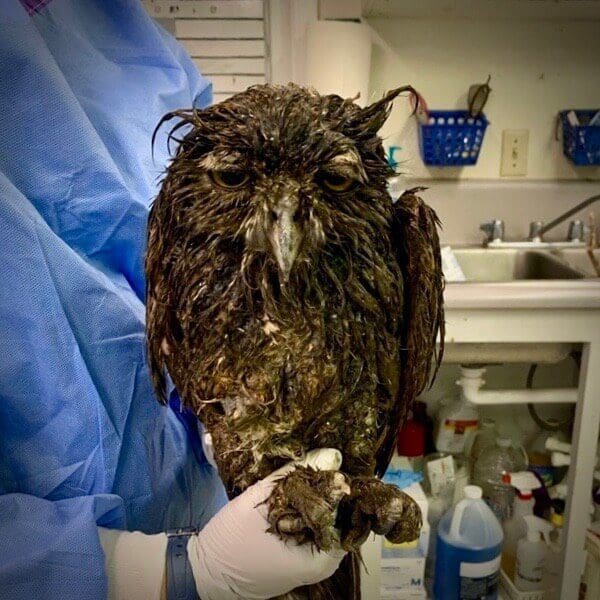
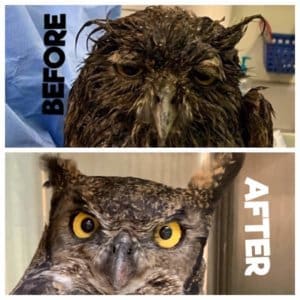 Party in the Hundred Acre Wood…
Party in the Hundred Acre Wood…

